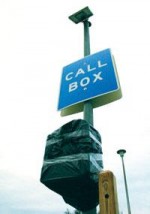Light plight

On a sprawling campus full of quiet corners, the blue glow of lights topping emergency phones may instill in students a sense of security.
But many of those lights are out. Nearly one-quarter of the 55 lights meant to aid students trying to contact University Police during emergencies weren’t functioning, a recent Oracle survey found.
The problem hasn’t escaped the notice of USF student Sarah Austin.
“They are supposed to have a bright blue light right at the very top,” said Austin, president of Necessary Improvements to Transform our Environment (NITE), a student group that advocates for campus safety. “So if you are walking in the middle of the night to get back to your car after studying in the Library, you could walk right by one and not even notice you passed something like that.”
Austin first noticed the problem last semester when her group hosted an event to educate students about the potential safety the emergency phones offer.
During the event, NITE conducted a student tour to 10 emergency phones located in central areas of the campus. The blue lights on about half the phones weren’t working, Austin said.
The survey, conducted by The Oracle on Feb. 8, revealed that on 13 of the 55 phones, the lights were malfunctioning.
But plans are underway to replace the aging emergency phones and their blue lights.
The new phones will use a more reliable, digital signal and will be connected directly to the nearest power supply. They will feature a blue light that remains lit, replacing the current blinking lights, which will make them easier to locate.
According to Brian Ippolito, Physical Plant coordinator of computer applications, most of the problems with the current lights lie in their reliance on solar rechargeable batteries. If the weather is cloudy, blocking direct sunlight for more than a day, many of the lights won’t function.
On USF’s Tampa campus, there are two types of phones. During the day, the trademark yellow box identifies the older phone, and the blinking blue light serves the same purpose at night. The newer phones – located near most resident halls – are blue cylinders that only flash in case of an emergency.
Ippolito coordinates a staff of around six people who tend to all of the alarm systems on campus and maintain the emergency phones. A team member checks every emergency phone each week, inspecting the light and testing the phone by calling University Police dispatch, Ippolito said. According to UP spokeswoman Lt. Meg Ross, the emergency phones are used almost daily to contact dispatch, but not all of those cases are emergencies.
Though the phones are old, they contain features designed to save lives in the event that the distressed caller is unable to speak.
“It should come up with the location of the phone and the phone number,” Ross said. “So even if the caller is unable to give us any information, we respond even if it appears to be a hang-up. Just like 911, we respond to the scene if we are unable to get a response.”
According to Ippolito, the Physical Plant has been authorized to replace 80 percent of the emergency phones.
The bidding process starts Friday. According to Ippolito, the Physical Plant hopes to have the new lights installed within a year.






